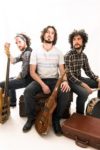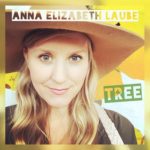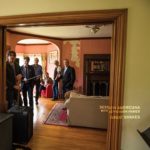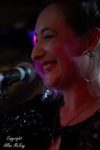
Here’s one for the guitarheads in London and the Southeast. The highly-respected and dynamic blues rock power trio Wille & the Bandits will be bringing their powerful live show to The 100 Club on Friday October 28th. The lineup is Wille Edwards (Lead Vocals, Electric and Acoustic Guitars, Electric Lap Steel, Weissenhorn and Dobro), Matt Brooks (Six String Electric Bass, Five String Double Bass, String Arrangements and Backing Vocals) and Andy Naumann (Drums and Percussion) and just one look at that list of instruments tells you that this is about serious musicianship.
The band has been praised by people who know their music, including Joe Bonnamassa and Bob Harris and their album “Steal” (Featuring Don Airey on three tracks) will be out soon on Jigsaw.
Watch the live video of “Virgin Eyes” and you’ll see what all the fuss is about:
 Just over a year after the release of her eponymous third album, Anna Laube has become Anna Elizabeth Laube and released her fourth album, “Tree”. She’s moved on from the playful experimentation of the previous album and produced a little classic of restrained melancholy where her pure, fluty vocals are set against sparse arrangements creating a lo-fi intimacy that perfectly matches the mood of the songs. With “Tree”, Anna has restricted her palette to sepia tones rather than the vibrant Technicolour of “Anna Laube”, although even the pared-down arrangements allow for some experimentation within the album’s sombre overall mood, which is enhanced with lashings of reverb on vocals and instruments.
Just over a year after the release of her eponymous third album, Anna Laube has become Anna Elizabeth Laube and released her fourth album, “Tree”. She’s moved on from the playful experimentation of the previous album and produced a little classic of restrained melancholy where her pure, fluty vocals are set against sparse arrangements creating a lo-fi intimacy that perfectly matches the mood of the songs. With “Tree”, Anna has restricted her palette to sepia tones rather than the vibrant Technicolour of “Anna Laube”, although even the pared-down arrangements allow for some experimentation within the album’s sombre overall mood, which is enhanced with lashings of reverb on vocals and instruments.
The album opens with a Dylan cover, “Wallflower”, a melancholy old-country waltz telling the story of two lonely people in a crowded room, complete with some lovely fiddle fills. And that’s not the last of the songs in three-four time; the imploring “I Miss You So Much” with its wailing harmonica, the love ballad “Longshoreman” and “Lose, Lose, Lose”, the story of recovery from alcoholism, ruined by the reappearance of an old flame (at Christmas of all times). If you spliced together Patsy Cline and Rickie Lee Jones, it would sound like this.
“XO” is a gentle finger-picked acoustic version of the Beyonce song, helped along by a trumpet accompaniment, not the usual strident brass, but a muted version with a Mexican tinge. And finally, two absolutely beautiful songs. The title song is the story of a tree and the way it, and other trees, intertwines with our lives. The gentle acoustic arrangement and lovely multi-tracked harmonies are a contrast to the over-driven, but quiet and tasteful guitar solo; all of the parts fit together perfectly. “Please Let it Rain in California Tonight” expands from concern about drought to become a secular Lord’s Prayer with piano backing. It’s a deeply moving piece that is so catchy you’ll be singing along on the first listen.
“Tree” is a flawless album that works with limited soundscapes to create a mood that’s mainly melancholy with a few lighter touches for contrast. It’s a very beautiful piece of work.
“Tree” is released on Aah…Pockets! Records (Aah …Pockets!4) on Friday October 21st.
 Review this album in one word? Gorgeous; ten beautifully-crafted and perfectly-arranged songs, six highly-gifted players and vocal harmonies to die for. If you’re looking for reference points, most of the songs here sound like they could have come from the late sixties/early seventies country-rock scene with understated playing, crystal clear production and those heavenly harmonies. “Great Shakes” is a perfect demonstration of the chemistry that great musicians can create when the stars are perfectly aligned. The album isn’t about the individual musicians, it’s about the contributions they make towards creating the best possible version of each song; in those terms, it’s a complete success, with each instrumental fill making each song that little bit more memorable.
Review this album in one word? Gorgeous; ten beautifully-crafted and perfectly-arranged songs, six highly-gifted players and vocal harmonies to die for. If you’re looking for reference points, most of the songs here sound like they could have come from the late sixties/early seventies country-rock scene with understated playing, crystal clear production and those heavenly harmonies. “Great Shakes” is a perfect demonstration of the chemistry that great musicians can create when the stars are perfectly aligned. The album isn’t about the individual musicians, it’s about the contributions they make towards creating the best possible version of each song; in those terms, it’s a complete success, with each instrumental fill making each song that little bit more memorable.
The members of Session Americana are Billy Beard (drums), Ry Cavanaugh (guitar), Kimon Kirk (bass), Jim Fitting (harmonica), Dinty Child (multi-instrumentalist) and Jefferson Hamer (guitar) and this is their seventh album as a collective, although it has a coherence that suggests a long-established band, rather than occasional collaborators. The album opens with the delicate country-rock feel of “One Skinner”, a story of a long-standing friendship with a musical setting featuring pedal steel and harmonica and a lead vocal with a vulnerability that suggests Neil Young or Iain Matthews and blossoms out into a hugely varied set of songs with subjects as varied as American history (“Great Western Rail”) and an umbrella (“Bumbershoot”). Five of the members contribute songs in different styles but always of the highest quality and usually with an interesting twist.
There isn’t a bad or even indifferent song on the album and there are a few that stand out. “Big Mill in Bogalusa” is a bluesy shuffle with some raw harmonica and harmonies from the whole band; it’s catchy and full of the feelgood. “Mississippi Mud” is a historical Southern story built around an over-driven guitar riff which morphs into an Allman Brothers boogie in the choruses and it leads into the album’s most poignant song, “One Good Rain”, with the message that every relationship, no matter how strong, can be vulnerable. Just the line ‘One good rain is all it takes to break the dam that love can make’ is one of the saddest things I’ve heard this year.
This album will wrap itself around you like a comfortable jumper on a winter night. It will make you smile at times and it might even make you cry, but you’ll certainly feel uplifted and full of admiration for the quality of the playing.
“Great Shakes” is released on October 14th.
 As far as interviews go, I think I’ve been really lucky. In six years, I’ve never had that experience of the uncooperative, bored, jet-lagged or just plain hostile interviewee. I’ve had to work in cupboards stage-side while rock bands soundchecked, but everyone I’ve met has been interesting and charming. I’m pleased to say that Rachael Sage (singer, songwriter, guitarist, pianist, artist and designer) extended my winning streak when I met up with her before her performance at the Discovery showcase at 229 on Great Portland Street to talk about her new album “Choreographic” and her current UK tour (among other things). I even added a new Yiddish word to my vocabulary. Here’s how it went:
As far as interviews go, I think I’ve been really lucky. In six years, I’ve never had that experience of the uncooperative, bored, jet-lagged or just plain hostile interviewee. I’ve had to work in cupboards stage-side while rock bands soundchecked, but everyone I’ve met has been interesting and charming. I’m pleased to say that Rachael Sage (singer, songwriter, guitarist, pianist, artist and designer) extended my winning streak when I met up with her before her performance at the Discovery showcase at 229 on Great Portland Street to talk about her new album “Choreographic” and her current UK tour (among other things). I even added a new Yiddish word to my vocabulary. Here’s how it went:
Allan – Hi Rachael.
Rachael – Hello.
Allan – How’s the tour going so far?
Rachael – The tour’s been really great. This tour’s a little bit different because, in addition to the club shows at night, we’re also doing workshops in the daytime along the tour route at various schools, either performing arts schools or the dance and drama departments of general schools along the way and it’s been fascinating. I’ve never really done that before; I’m not a teacher, I’m kind of inexperienced at that, but I seem to have a special relationship with kids between nine and fourteen so we’ve been enjoying and learning a lot.
Allan – And presumably that means that you’re performing at unusual times.
Rachael – Indeed it does. We’ve had some crazy call-times to meet at the tour van in the morning, like seven-thirty in the morning to drive a couple of hours to perform at 10 a.m. Actually, this morning we played at 9:30. But on the upside, our jet-lag is so confused that it’s non-existent; we don’t know what time zone we’re in. When we go home to New York, it’ll probably be easier to re-acclimate.
Allan – When you come to the UK, do you find the audiences very different from American audiences?
Rachael – I suppose it would be more politically correct to say no, that audiences everywhere and every environment around the world are just about the same, because people are people and we have deduced that people around the world love music the same amount and they all want the same things out of life and there is that unifying theme that we experience. But in terms of audience reactions we’ve found UK audiences and European audiences in general to be a lot more open and expressive when they really, really like something and it’s not necessarily loud whistling or heckling. They’ll come up to you after shows and have that familiarity and treat you like you’re their buddy they’ve known forever and talk to you about their own lives and themselves; it’s just an openness and we love that, that’s part of why we keep coming back.
Allan – I’ve spoken to American artists who think when they start the set that they’re dying on stage and suddenly at the end of the song, the audience erupts.
Rachael – I’ve experienced that to an extreme in Japan, where you think you’re not going over at all; they must hate it, and afterwards there’s the most gentle clapping and they come up to the merch table and they want to buy all your CDs when you weren’t even certain they were into it. People have their own way of processing music and there really is no wrong. As long as nobody throws tomatoes, we’re happy.
Allan – I understand there’s an interesting event you’re involved in at the end of the tour as well at the Royal Albert Hall.
Rachael – The Dance Prom? That’s an event where we’re running a contest and the school that performs the winning routine to one of my songs will receive a scholarship from my record label Mpress Records and myself. I’m not performing at the event, but it’s very much tied in to the “Choreographic” dance theme of this tour. We’re going to be back in London at the O2 Academy in Islington on October 28th, and The Bedford on November 1st. Looking forward to that.
Allan – For the benefit of the MusicRiot audience, tell me a bit about your background, because it’s been very varied, hasn’t it?
Rachael – It has, and yet everything has had the thread of music really. I started playing piano by ear when I was about two and a half/three years old which the exact same time I was thrust into a pre-ballet where really all you’re doing is running around and spinning around and having fun, somewhere for you to be busy while your Mom gets a break, but it quickly bloomed into a full-blown young ballet career and I ended up becoming quite serious as a ballet dancer and at the same time very serious about being a songwriter. I learned to play by ear pretty much exclusively from sounding out all the music I heard every day in dance class. So I would go home and play all these classical pieces and I have no knowledge of the composers or what they were called because it was an informal education, but it was a very thorough education and I think my sense of melody and dynamics really stemmed from classical music.
Jumping ahead, I kept the songwriting up and I pretty much knew, I wanted to be a professional singer/songwriter and composer well before high school, maybe at thirteen/fourteen. Then for my Bat Mitzvah, my relatives got together and bought me a four-track tape recorder. Once I mastered that, I fancied myself as a budding producer, bouncing vocal tracks and having a good time with that, and by the time I went to college, I was very firm that I wanted to be a recording artist and tour the world doing pretty much what I’m doing now, so I guess I was a planner.
Allan – I’ve spoken to artists who agonise about the genre they’re working in and the way it affects sales of their work…
Rachael – There’s an expression in Yiddish that I have to respond to that; it’s spelt F-E-H. Genre’s a useful tool to help maybe turn people on to your music to be able to describe it in an elevator pitch, as they say. Actually, yesterday another writer asked me ‘How would you describe your music in three words?’, and I said colourful chamber pop. The reason I said that was first of all, I’m in England and I feel like you have a unique appreciation of pop music and also that pop music is a broader genre here. If you say pop in America, people assume you mean Katy Perry and here it could mean The Beatles or Elvis Costello, you know, pop/rock, so it’s broad enough to feel like I’m at home in that category.
Allan – With “Choreographic”, you’ve pretty much invented your own genre, haven’t you?
Rachael – Oh my goodness, thank you. I didn’t invent the word, unfortunately. I guess what I did, what’s interesting is that my music was being used and embraced by the lyrical dance community in America and also over here well before I was aware of it and then a few of my diehard supporters started sending me YouTube links where I would see these full-blown dances to my songs in competitions and winning awards and I didn’t really know about that competitive dance culture because the in dance culture that I grew up with, there were no contests; it was strict ballet and that wouldn’t have been allowed, but it was fascinating to see these young, very prodigious, hard-working kids performing and interpreting the music in a way that that was completely different from how I might have envisioned it and sort of humbling. At the end of the day, you create it and the minute it comes out of you, it’s really not yours anymore; it’s collective ownership and I love that. Eventually when the show ‘Dance Moms’ started using the music, it brought me back to that time in my youth when dance was a huge part of my life and it defined who I was as a person and I hadn’t really thought about that time for a long time. When you’re a former ballerina, you kind of put it behind you because there’s some bitter-sweetness; it was painful and very gratifying, like breaking up with an ex-boyfriend or girlfriend. You move on and you let it go, but this was a good time to revisit it and come at it musically from a more positive angle, I would say.
Allan – With “Choreographic”, there must be certain elements that make it work for that kind of interpretation.
Rachael – Yes, what happened originally was that they were using all these different songs from various albums of mine and of course there were different types of songs on those albums, but the ones they were using were usually very pianistic and very arpeggiated. I guess the average person might say there were hints of classical technique in the piano playing, and then also a lot of stringed instruments, cellos and violins, so I picked up on that. More than anything when I sat down to make this album, I tried to come at it more from a visual perspective of what I thought would work in a multi-media context with dance and music and I could only go by what my imagination was offering. I have done some choreography in my day, it’s not my forte, but I’m such an avid fan of dance and choreography in general that I have a pretty good sense of dynamics and what might be danceable, so that’s really where I was coming from. I also had the visual in my head of perhaps, one day, bringing one dancer or several dancers on tour with me and doing more of a show that’s theatrical as well as pop and that’s still in the works. We’re thinking about mounting something along those lines in New York in January.
Allan – Presumably, as well as the musical side, it has to have a fairly strong narrative as well. Your songs tell stories.
Rachael – Well, the genre of dance which has embraced my music most has indeed been lyrical dance, which is this term I had no familiarity with and I see these young girls, sometimes boys, but not as often, interpreting the music, usually very literally. I have a song called “Barbed Wire”, which was performed on ‘Dance Moms’ and the song itself is about someone in your life who can’t make up their mind and they’re very ambivalent, and how frustrating that is for you when you are certain how you feel. I think adults or maybe contemporary professional dancers might have interpreted it with more of an abstract approach, where you felt the emotion but it wasn’t quite so literal and of course the ten/eleven/twelve year olds literally had a backdrop of a barbed wire fence and were climbing it and interacting with it, and that was so interesting because it hints at the idea of doing a live show where the average person sometimes does need those very accessible touch zones to identify with a new art form.
Allan – Is it true that you actually wrote the album here in London as well?
Rachael – I did, yes. I wrote it in Camden. I had two festivals pretty far apart for me. I like to fill every single day, because I’m a busy OCD kind of an artist and I don’t like days off; they make me nervous. We were coming up on those shows and we had choice between trying to pick up some radio in between or just leave that gap and I said ‘You know what, it’s time for me to write a record.’ I’ve never quite set that deadline for myself before. I usually just let it happen organically; over the course of a year, I write twelve songs and then I have an album and then I’m ready to go record, but I had recently reunited socially with my co-producer from many, many years ago, Andy Zulla, who did my first few records with me, and we hit it off again so beautifully and we got all excited to collaborate again. He said to me ‘When you come back from England, if you have a batch of tunes ready, I can record with you in August and then I’ll be busy again after that, but keep me posted.’ That was a driver as well; I wanted to come back armed, like a fashion designer would feel: ‘I want that fall line all ready to go’. I had five days in Camden, so I holed myself up in a hotel, ditched the car and the tour van and stayed at a Holiday Inn Express. I’d go walking every day and just take in the energy of the city and then I wouldn’t let myself go to sleep unless I’d written at least one song. So that’s the story of how this record was written. It was during Glastonbury Festival too so that was what I watched if anything on the television and it kind of inspired me as well.
Allan – Apart from music and dancing, you have other artistic interests as well, haven’t you?
Rachael – I do, and that’s also why I was drawn to the word choreographic, because I’m a visual artist and I’m a graphic designer, but it evolved more out of necessity than anything else because I run my own record label and when you do that you have to wear a lot of hats, so there have been times when I felt I would just do better designing my own artwork because I had a specific vision. I just figured it all out and so there’s that graphic, visual aspect to my work and there are many artists I admire who have that as well like David Bowie, Kate Bush and David Byrne, so many artists, even John Mellencamp, Tony Bennett, who I admire and I’ve become very interested in their artwork as well and that helps me to have a window into another side of them. I hope that people explore that aspect of my work as well and I have a section on my website, ’Visuals’, where you can see my paintings and collage, and just recently I developed some wearable art; I’ve been painting on jackets and dresses and things like that and it’s just another fun outlet for me creatively.
Allan – I’m always fascinated that most of the very gifted musicians I know have various other artistic interests, like photography, as well…
Rachael – Probably keeps them sane…
Allan – One last question, is there any particular song that always make you cry?
Rachael – My favourite contemporary folk artist is Glen Hansard. I was recently at his concert at Carnegie Hall and I was weeping like a little baby. It’s on his new record. He composed the music for the movie “Once”, which was such an incredible music film and the song’s called “My Little Ruin”. He’s an Irish songwriter who was with The Frames with and there was a Broadway show created from “Once”, which won the Oscar for best song and it ran in the UK and Ireland as well. He’s in the vein of Damien Rice, that kind of vibe, beautiful string section, acoustic guitar and I’m a big Irish music fan. Anything Irish makes me cry.
Allan – Many, many thanks Rachael.
Rachael’s album “Choreographic” is released in the UK on November 11 on MPress Records. You can also see photos from Rachael’s performance at 229 here.


